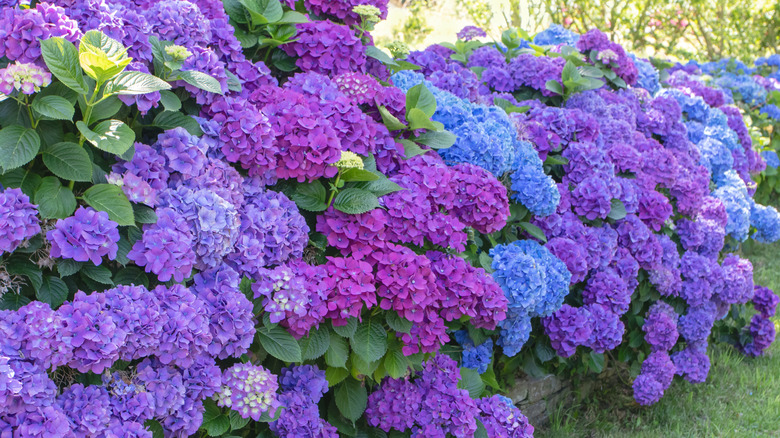The Best Place To Plant Broadleaf Hydrangeas For Maximum Bloom Potential
In my work as a gardener, I am often asked about hydrangea care. The number one question about hydrangeas in upstate New York, where I live and work, is how to get them to bloom more vigorously. Broadleaf hydrangeas (Hydrangea macrophylla), also known as bigleaf hydrangeas, can put on a showcase of blue or pink blooms in summer. But they can be somewhat sensitive to cold winter weather, and this can affect formation of new flower buds. I'd like to share tips for successful hydrangea blooms by choosing the best places to plant hydrangeas in the garden for good winter protection. Planting your broadleaf hydrangeas where they are shielded from extreme winter weather will help ensure the tender buds don't freeze.
If you live in USDA Zone 5, you may find that broadleaf hydrangeas are tricky for you to grow. They do bloom in this zone, but many are best suited to USDA Zones 6 to 9. Some gardeners choose to plant cold-hardy varieties, such as 'BloomStruck' or 'Mini Mauvette' (one of my favorites for its hardy nature and beautiful mauve pink flower heads). But if you already have some broadleaf hydrangeas, you may be able to move them to a more suitable location to help protect them in winter.
There are various ways to protect cold-sensitive shrubs from harsh winter weather. You can cover them for wind protection, using burlap or other suitable materials appropriate for covering shrubs in winter. Some people place folding wood frames over them to prevent build up in heavy snowstorms. But location is more important than you might think.
Protecting your hydrangeas from winter weather
As beautiful as your flowering hydrangeas may be in an open location, this doesn't provide as much winter protection as planting them near a structure. There are two important benefits this can provide: protection from winter wind and warmth during cold weather. Wind can worsen the effect of cold temperatures, and high winds can potentially cause damage in the form of broken branches.
Planting your broadleaf hydrangeas next to your house is a way to shield them from high winds. Also, if your house is made of brick or stone, these materials often hold more heat over the long term, and that heat helps keep your nearby shrubs a bit warmer in winter. I have noticed that hydrangeas planted next to brick or stone houses often appear more healthy and hardy than those planted in an open setting where they are exposed to wind and snow. This is yet another reason to think twice before planting blue hydrangeas next to a concrete walkway out in the open.
The other consideration when planting next to your house, garage, or other structure is sunlight exposure. Most gardeners are familiar with how the direction of sunlight shifts in the winter months, and they plant things accordingly. Preparing your hydrangeas for winter includes planting them where they receive some winter sunlight. This can help prevent ice from forming on their stems, which can in turn freeze the young buds, preventing them from flowering. Afternoon sunlight is a bit more intense and warmer, but morning sunlight is also good if that's what you have.
Winter shelter tips for broadleaf hydrangeas
If your broadleaf hydrangeas are already established and you're reluctant to move them, you can do some things to help shelter them in winter. You can build a structure near them, such as an arbor or trellis, to help shield them from wind. An arbor can be a picturesque choice, and you can add a climbing plant as a colorful accent to your hydrangeas. Blue or pink flowering hydrangeas look great with contrasting colors such as red or yellow climbing roses or purple or white clematises.
If you don't want to build a permanent structure, place something temporary around your hydrangeas in winter for wind protection. This is an easy DIY project using materials such as sawhorses, pieces of wooden trellis, and some burlap fabric or plant sheeting material secured with staples or clothespins. This method is also useful if there is a late frost in spring that might harm buds.
One very easy method for protecting your hydrangeas from cold temperatures is also to put a layer of natural mulch around the base of the plants. This won't shelter the branches from wind, but it lends warmth to the roots and preserves moisture. A dry autumn can make hydrangeas somewhat vulnerable to winter damage, so mulching adds important insulation. I have used pine bark mulch and pine straw for mulching broadleaf hydrangeas, and these both work well in winter to help keep the roots healthy.


